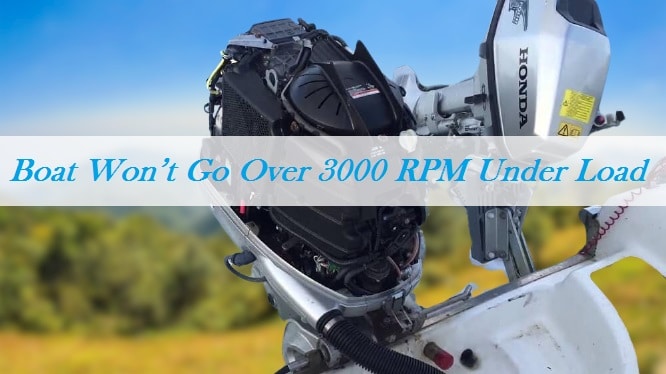As a boat owner, you’ll want to get the most from your vessel. You can use it for an abundance of activities, including fishing, hunting, traveling, and relaxing. In addition to this, there is a good chance that you’re going to use your boat for parties and other get-togethers. Doing so can be extremely fun. However, there is a risk that you’re going to overload your boat. If so, this will dramatically reduce the boat’s RPM. You need to find out why your boat’s RPMs have dropped so quickly, why Boat Won’t Go Over 3000 RPM Under Load.
Why would your boat’s RPMs drop significantly? Below, you’ll find out more about this subject.
Boats & RPM
Before getting into the specifics, it is a good idea to learn more about RPMs and boats. What does RPM stand for and what does it mean? Well, RPM stands for revolutions per minute. It specifies the number of turns each minute. RPM can be used in many situations. For instance, you’re going to see the term RPM when you begin looking at computer hard drives.
If the hard drive has a higher RPM rating, it will be able to access data faster. In addition to this, RPM is often used when discussing cars, trucks, SUVs, boats, and other vehicles. When it comes to an automobile, the RPM tells you how fast the machine is operating at any point.
Boats are normally propped to operate in a wide-open throttle. You’ll need to check the owner’s manual to find out what the WOT is. If the motor has a WOT of 5,000 to 5,800, the boat will likely reach 5,400 RPMs when it is operating wide open.
However, you need to realize that certain factors can impact the boat’s RPMs. What happens if your boat won’t go over 3,000 RPM while under load? It could be a major or minor problem. Below, you’ll find out about some of the reasons your boat won’t reach a higher RPM.
Why Your Boat Won’t Exceed 3000 RPM When Under Load
Why won’t your boat reach a higher RPM? Does it have something to do with a damaged component? If so, you’ll need to identify the problem and replace the part immediately. Although this is one possibility, there are more.
Using The Wrong Fuel
First and foremost, you need to make sure that you’re using the right fuel. If you’re not, you’re going to experience several issues. Remember that boats use gasoline that contains ethanol. For the best results, it should have at least 10% ethanol. This chemical helps oxygenate the gas to ensure it burns efficiently.
When you use this type of fuel, your boat’s engine will be able to run more efficiently while generating lower emissions. In addition to this, the right fuel will have a major impact on the power of your engine.
The only issue is that ethanol will cause old fuel to get stale. Plus, ethanol attracts moisture so you might have water in your fuel. If you do, the combustion capabilities will be dramatically altered. If you’re worried that your boat can’t reach a higher RPM due to fuel issues, you’ll want to empty the tank. Clean it before adding new fuel.
Inappropriate Propeller
When using the wrong propeller, your boat likely won’t be able to exceed 3,000 RPMs while under load. When choosing the propeller, it is vital to choose the right size. Using the wrong size will create issues and it’ll reduce the engine’s RPMs.
Remember that the RPM and the propeller size are closely linked. Add an inch to the diameter of the propeller and the RPM will be used by as much as 500 revolutions. Add an inch to the blade’s pitch and it’ll be reduced by roughly 150 or 200 revolutions.
In general, most boats should reach 6,000 RPM. If yours can’t reach that high, there is a risk that you’re using the wrong propeller.
Debris, Dirt, And Algae
As a boat owner, you need to go above and beyond to keep your boat in pristine condition. Failing to do so will lead to big issues in the future. You’ll need to go above and beyond to keep your boat clean and tidy. You need to take care of barnacles and algae that could be stuck to your boat’s propeller. If it is interfering with the propeller’s ability to operate, it will likely decrease the RPMs of the engine. To prevent this from happening, you should clean your boat regularly.
Put together a schedule to make sure you clean your body and all important components at least three or four times a year. You’ll also need to focus on keeping the carburetor clean.
Dirty Carburetor
If your boat cannot exceed 3,000 RPM when under load, there is a chance that you’re dealing with a malfunctioning or filthy carburetor. Unfortunately, this is one of the most common causes, and it’ll lead to a handful of other problems.
The carburetor should combine the correct amount of air and fuel before adding it to the cylinders or combustion chambers. If it is not working properly, it is going to hinder the engine’s performance. If you’re worried that something is wrong with your carburetor, you’ll need to look for the most common symptoms.
A malfunctioning or dirty carburetor will cause poor idling, slow start, and cylinder misfires. Take out the drain screw from the bottom of the carburetor. If you don’t find fuel there, something is likely wrong with the carburetor.
To remedy the problem, you’ll want to try cleaning or replacing the carburetor. You can start by using a carburetor cleaner. If that doesn’t work, you might want to hire a professional to check it.
Ignition System Issues
If something has happened to the ignition system, it could have a negative impact on your boat’s RPMs. You can determine whether this is the problem by using a spark tester. Just remember that ordinary consumers likely won’t be able to tackle this problem on their own.
If you have limited experience with this, you should think about hiring a professional to tackle the problem. Still, you can likely do it on your own as long as you’re careful and work slow.
If you’re confident that you can test the problem without professional help, follow the tips below. Otherwise, hire a qualified mechanic and minimize the risks involved.
- Start by taking out the coil wire.
- Once you’ve done that, you’ll need to touch the test to the center of the wire.
- Then, you’ll want to connect the tester to the engine’s ground.
- Start the engine ignition.
Do you see a spark? If so, you can rest assured knowing that the system is working ad intended. If you don’t see a spark, you have a problem to deal with. You’ll need to find out which spark plugs have issues so you can replace them as quickly as possible. Once you’ve done that, you might have fixed the problem.
Engine Overheating
Have you noticed that your engine is overheating often? Unfortunately, this is a serious problem and you need to fix the issue as soon as possible. If the engine is overheating, you can guarantee that it isn’t going to reach more than 3,000 RPMs. It might not even go that high.
One of the biggest issues associated with this problem is that an engine can overheat for many reasons. Identifying the cause will prove to be very difficult. You’ll need to make a list of potential causes and strike them from your list after checking them. Below, you’ll find a list of some of the reasons your engine may overheat.
- The engine oil isn’t circulating correctly
- Something has gone wrong with the water pump
- The thermostat has failed
- The manifold, riser, or impeller is damaged
- You don’t have enough engine oil
- One or more of the spark plugs are faulty
If you cannot fix these issues on your own, you shouldn’t. It is too risky. Instead, you’ll want to hire a qualified mechanic so you can get your boat back out on the water before you know it.
The Boat is Overloaded
If your boat hasn’t been able to exceed 3,000 RPMs, you might’ve overloaded it. If this is the case, you’re loading down the boat too much and you need to lighten its load quickly. Putting it under too much weight for too long can lead to bigger issues.
The boat might be hauling too many people or too much gear. If the boat is overloaded, you’re going to notice a big difference. The RPMs will be dramatically lower than they should be. Plus, you’ll notice that the boat’s performance is not good.
Neutral Safety Switch Issues Finally, you’ll need to inspect the neutral safety switch. In some cases, it’ll go bad so it’ll need to be replaced. However, you might be able to fix the issue by unplugging the switch before plugging it back up. If the switch needs replaced, it is best to hire a mechanic.
Read Also: What Should You Do Immediately If A Boat Motor Catches Fire?

Ever wondered how you can have a cruising boat without getting into financial problems? The answer is here. That is the reason why we set up this blog to share with you, safety tips, answers to questions that have to do with fishing and hunting. You are going to love it!
Hey! I am Armstrong!

